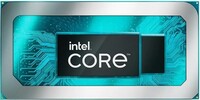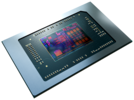Intel Core 7 250H vs AMD Ryzen 7 8745HS vs Intel Core 9 270H
Intel Core 7 250H
► remove from comparison
The Intel Core 7 250H is a high-end mobile CPU for laptops based on the Raptor Lake-H series (Alder Lake architecture). It was announced in late 2024 and offers 6 performance cores (P-cores, Golden Cove architecture) and 8 efficient cores (E-cores, Gracemont architecture). The P-cores support Hyper-Threading for 20 threads when combined with the E-cores. The clock rates range from 2.5 to 5.4 GHz (single core turbo) on the performance cluster and 1.8 to 4 GHz on the efficiency cluster. The performance of the E-cores should be similar to old Skylake cores (compare with the Core i7-6920HQ). All cores can use up to 24 MB L3 cache.
The CPU clocks with up to 5.4 GHz. Compared to the similar i7-13700H, the 250H offers a higher clock rates (e.g. +400 MHz boost clock speed) and a supports up to DDR5-5600.
Performance
Due to the higher boost core clock, the Core 7 250H should be slightly faster than the old Core i7-13700H. Especially single threaded workloads should profit from the improvements.
Features
The integrated memory controller supports various memory types up to DDR5-5600 (up from 5200 MHz for the 12th gen). The Thread Director (in hardware) can support the operating system to decide which thread to use on the performance or efficient cores for the best performance. For AI tasks, the CPU also integrates GNA 3.0 and DL Boost (via AVX2). Quick Sync in version 8 is the same as in the Rocket Lake CPUs and supports MPEG-2, AVC, VC-1 decode, JPEG, VP8 decode, VP9, HEVC, and AV1 decode in hardware. The CPU now supports PCIe 5.0 x8 for a GPU and two PCIe 4.0 x4 for SSDs.
The integrated graphics adapter is based on the Xe-architecture and offers 96 EUs (Execution Units) clocked at up to 1.55 GHz.
The CPU is rated at 45 W base power (115 W PL2) but most laptops will use a PL1 of around 60 Watt. The SoC is manufactured on an improved 10nm process at Intel, which is known as Intel 7.
AMD Ryzen 7 8745HS
► remove from comparison
The Ryzen 7 8745HS is a China-only Hawk Point family chip that never received an official launch. Targeted at gaming and productivity laptops but widely used in mini-PCs, too, the 8745HS features 8 cores (16 threads thanks to SMT support) running at up to 4.9 GHz, along with the still fairly capable Radeon 780M iGPU. There is no NPU here.
As an APU meant for use within China, this Ryzen 7 should be fully compliant with the Chinese government-approved cryptography standards.
The only difference between the 8745HS and the 8745H is the slightly lower default wattage of the latter, potentially leading to slightly lower clock speeds.
Performance
We fully expect this Zen 4 architecture processor to be about as fast as the Ryzen 7 7745HX (8 Zen 4 cores, 3.6 GHz to 5.1 GHz) meaning its multi-thread performance is a little better than the Core Ultra 9 185H but a few percentage points behind the Ryzen AI 9 HX 370.
Architecture and Features
Unlike Zen 3, Zen 4 features AVX512 support along with other improvements, like larger caches/registers/buffers across the board. Elsewhere, the 8745HS has 16 MB of L3 cache and a fast RAM controller (up to LPDDR5x-7500 and up to DDR5-5600). There are 20 PCI-Express 4 lanes for connecting devices such as NVMe SSDs (1.97 GB/s per lane) and graphics cards; USB 4 / Thunderbolt support is onboard, too. Please note that the APU isn't overclockable and neither is it user-replaceable. It gets soldered on to the motherboard for good (FP7r2 or FP8 socket interfaces).
Graphics
The Radeon 780M (12 CUs / 768 shaders, up to 2,600 MHz) can drive 4 monitors simultaneously with resolutions as high as SUHD 4320p. It will also have little issue hardware-encoding and hardware-decoding the most widely used video codecs (AV1, AVC, HEVC). As far as gaming is concerned, many titles are still playable at 1080p as of early 2025 albeit with most settings dialed down do Lowest or Low.
Power consumption
This Ryzen 7 series chip has a long-term power limit (default TDP) of 35 W to 54 W, giving system makers a choice between improving battery life and making the system they're designing faster. Either way, an active cooling solution is a must for a laptop or a mini-PC built around this APU.
Intel Core 9 270H
► remove from comparison
The Intel Core 9 270H is a high-end mobile CPU for laptops based on the Raptor Lake-H series (Alder Lake architecture). It was announced in late 2024 and offers 6 performance cores (P-cores, Golden Cove architecture) and 8 efficient cores (E-cores, Gracemont architecture). The P-cores support Hyper-Threading for 20 threads when combined with the E-cores. The clock rates range from 2.7 to 5.8 GHz (single core turbo) on the performance cluster and 2 to 4.1 GHz on the efficiency cluster. The performance of the E-cores should be similar to old Skylake cores (comparable with the Core i7-6920HQ). All cores can use up to 24 MB L3 cache.
Compared to the pre-refresh top model, the Core i9-13900H, the Core 9 270H offers a 400 MHz higher Turbo clock speed and supports slightly faster DDR5-5600 RAM.
Performance
The average Core 9 270H should be slightly faster than a Core i9-13900H thanks to the higher Turbo clock speed. Especially single core workloads can profit from the higher frequency. Supplied with ample cooling and TDP, the Core 9 270H should be sufficient even for very demanding tasks.
Features
The integrated memory controller supports various memory types up to DDR5-5600 (up from 5200 MHz for the 13th gen). The Thread Director (in hardware) can support the operating system to decide which thread to use on the performance or efficient cores for the best performance. For AI tasks, the CPU also integrates GNA 3.0 and DL Boost (via AVX2). Quick Sync in version 8 is the same as in the Rocket Lake CPUs and supports MPEG-2, AVC, VC-1 decode, JPEG, VP8 decode, VP9, HEVC, and AV1 decode in hardware. The CPU now supports PCIe 5.0 x8 for a GPU and two PCIe 4.0 x4 for SSDs.
The integrated graphics adapter is based on the Xe architecture and offers 96 EUs (Execution Units) that are clocked at up to 1.55 GHz.
The CPU is rated at 45 W base power (115 W PL2) but most laptops will use a PL1 of around 60 Watt. The SoC is manufactured on an improved 10nm process at Intel, which is known as Intel 7.
| Model | Intel Core 7 250H | AMD Ryzen 7 8745HS | Intel Core 9 270H | ||||||||||||||||||||||||||||||||||||||||||||||||||||||||||||||||||||||||||||||||||||||||||||||||
| Codename | Raptor Lake-H Refresh | Hawk Point-HS (Zen 4) | Raptor Lake-H Refresh | ||||||||||||||||||||||||||||||||||||||||||||||||||||||||||||||||||||||||||||||||||||||||||||||||
| Series | Intel Raptor Lake-H | AMD Hawk Point (Zen 4/4c) | Intel Raptor Lake-H | ||||||||||||||||||||||||||||||||||||||||||||||||||||||||||||||||||||||||||||||||||||||||||||||||
| Series: Raptor Lake-H Raptor Lake-H Refresh |
|
|
| ||||||||||||||||||||||||||||||||||||||||||||||||||||||||||||||||||||||||||||||||||||||||||||||||
| Clock | 1800 - 5400 MHz | 3800 - 4900 MHz | 2000 - 5800 MHz | ||||||||||||||||||||||||||||||||||||||||||||||||||||||||||||||||||||||||||||||||||||||||||||||||
| L1 Cache | 1.2 MB | 1.2 MB | |||||||||||||||||||||||||||||||||||||||||||||||||||||||||||||||||||||||||||||||||||||||||||||||||
| L2 Cache | 11.5 MB | 8 MB | 11.5 MB | ||||||||||||||||||||||||||||||||||||||||||||||||||||||||||||||||||||||||||||||||||||||||||||||||
| L3 Cache | 24 MB | 16 MB | 24 MB | ||||||||||||||||||||||||||||||||||||||||||||||||||||||||||||||||||||||||||||||||||||||||||||||||
| Cores / Threads | 14 / 20 6 x 5.4 GHz Intel Raptor Cove P-Core 8 x 4.0 GHz Intel Gracemont E-Core | 8 / 16 8 x 4.9 GHz AMD Zen 4 | 14 / 20 6 x 5.8 GHz Intel Raptor Cove P-Core 8 x 4.1 GHz Intel Gracemont E-Core | ||||||||||||||||||||||||||||||||||||||||||||||||||||||||||||||||||||||||||||||||||||||||||||||||
| TDP | 45 Watt | 35 Watt | 45 Watt | ||||||||||||||||||||||||||||||||||||||||||||||||||||||||||||||||||||||||||||||||||||||||||||||||
| TDP Turbo PL2 | 115 Watt | 115 Watt | |||||||||||||||||||||||||||||||||||||||||||||||||||||||||||||||||||||||||||||||||||||||||||||||||
| Technology | 10 nm | 4 nm | 10 nm | ||||||||||||||||||||||||||||||||||||||||||||||||||||||||||||||||||||||||||||||||||||||||||||||||
| max. Temp. | 100 °C | 100 °C | 100 °C | ||||||||||||||||||||||||||||||||||||||||||||||||||||||||||||||||||||||||||||||||||||||||||||||||
| Socket | BGA1744 | FP7r2/FP8 | BGA1744 | ||||||||||||||||||||||||||||||||||||||||||||||||||||||||||||||||||||||||||||||||||||||||||||||||
| Features | DDR4-3200/LPDDR4x-4266/DDR5-5200/LPDDR5-6400/LPDDR5x-6400 RAM, PCIe 5, Thr. Dir., DL Boost, GNA, MMX, SSE, SSE2, SSE3, SSSE3, SSE4.1, SSE4.2, AVX, AVX2, BMI2, ABM, FMA, ADX, SMEP, SMAP, EIST, TM1, TM2, HT, Turbo, SST, AES-NI, RDRAND, RDSEED, SHA | DDR5-5600/LPDDR5x-7500 RAM, PCIe 4, USB 4, AVX, AVX2, AVX512, FMA3, MMX (+), SHA, SSE, SSE2, SSE3, SSSE3, SSE4.1, SSE4.2, SSE4A | DDR4-3200/LPDDR4x-4266/DDR5-5600/LPDDR5-6400/LPDDR5x-6400 RAM, PCIe 5, Thr. Dir., DL B., GNA, vPro Ent., RPE, MMX, SSE, SSE2, SSE3, SSSE3, SSE4.1, SSE4.2, AES, AVX, AVX2, FMA3, SHA | ||||||||||||||||||||||||||||||||||||||||||||||||||||||||||||||||||||||||||||||||||||||||||||||||
| iGPU | Intel Iris Xe Graphics G7 96EUs ( - 1500 MHz) | AMD Radeon 780M ( - 2600 MHz) | Intel Iris Xe Graphics G7 96EUs ( - 1550 MHz) | ||||||||||||||||||||||||||||||||||||||||||||||||||||||||||||||||||||||||||||||||||||||||||||||||
| Architecture | x86 | x86 | x86 | ||||||||||||||||||||||||||||||||||||||||||||||||||||||||||||||||||||||||||||||||||||||||||||||||
| Announced | |||||||||||||||||||||||||||||||||||||||||||||||||||||||||||||||||||||||||||||||||||||||||||||||||||
| Manufacturer | ark.intel.com | www.amd.com | ark.intel.com | ||||||||||||||||||||||||||||||||||||||||||||||||||||||||||||||||||||||||||||||||||||||||||||||||
| Die Size | 178 mm2 |
Benchmarks
Average Benchmarks Intel Core 7 250H → 100% n=2
Average Benchmarks AMD Ryzen 7 8745HS → 90% n=2
Average Benchmarks Intel Core 9 270H → 108% n=2
* Smaller numbers mean a higher performance
1 This benchmark is not used for the average calculation













